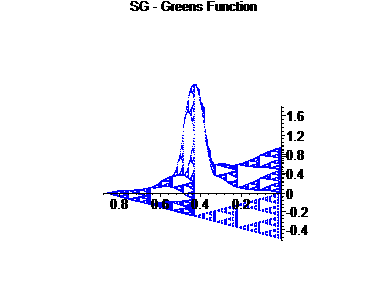SG2

|
is solved by
|
Green's function on SG2 is known to have the following properties:
| It is zero on the boundary | |
| Fixing y, Green's function is harmonic everywhere except at x=y, where it has a singularity. In other words, x ¹ y, DG(x,y) = 0 | |
| Theoretically, Green's function should obey a power law: G(x,y) £ c d(x,y) d¢-1, where d(x,y) is the metric and d¢ is the dimension of SG2 |
Unlike other functions, such as the heat kernel or pluriharmonic functions, Green's function changes drastically from the case of SG to that of SG2. For example, comparing the unit interval to the square, the Green's function goes from having a point of non-differentiability at x=y to having a pole at its singularity. On the SG and SG2, we expect to have a very similar situation, with a pole at the singularity for SG.
We use the FEM to approximate a solution of Green's Function on the SG2, by using the fact that DG = 0 except at the singularity. We set q=0 in (3) and F=0 except at the point in the spline which corresponds to the singularity; there, F=1. Thus, the approximation is:
|
(4) |
In order to display the solutions to these equations, we graphed the picture of y¢ÄSG and SG Äy¢¢. In the following graphs, we show the approximations of G(x,y) for various fixed y.
